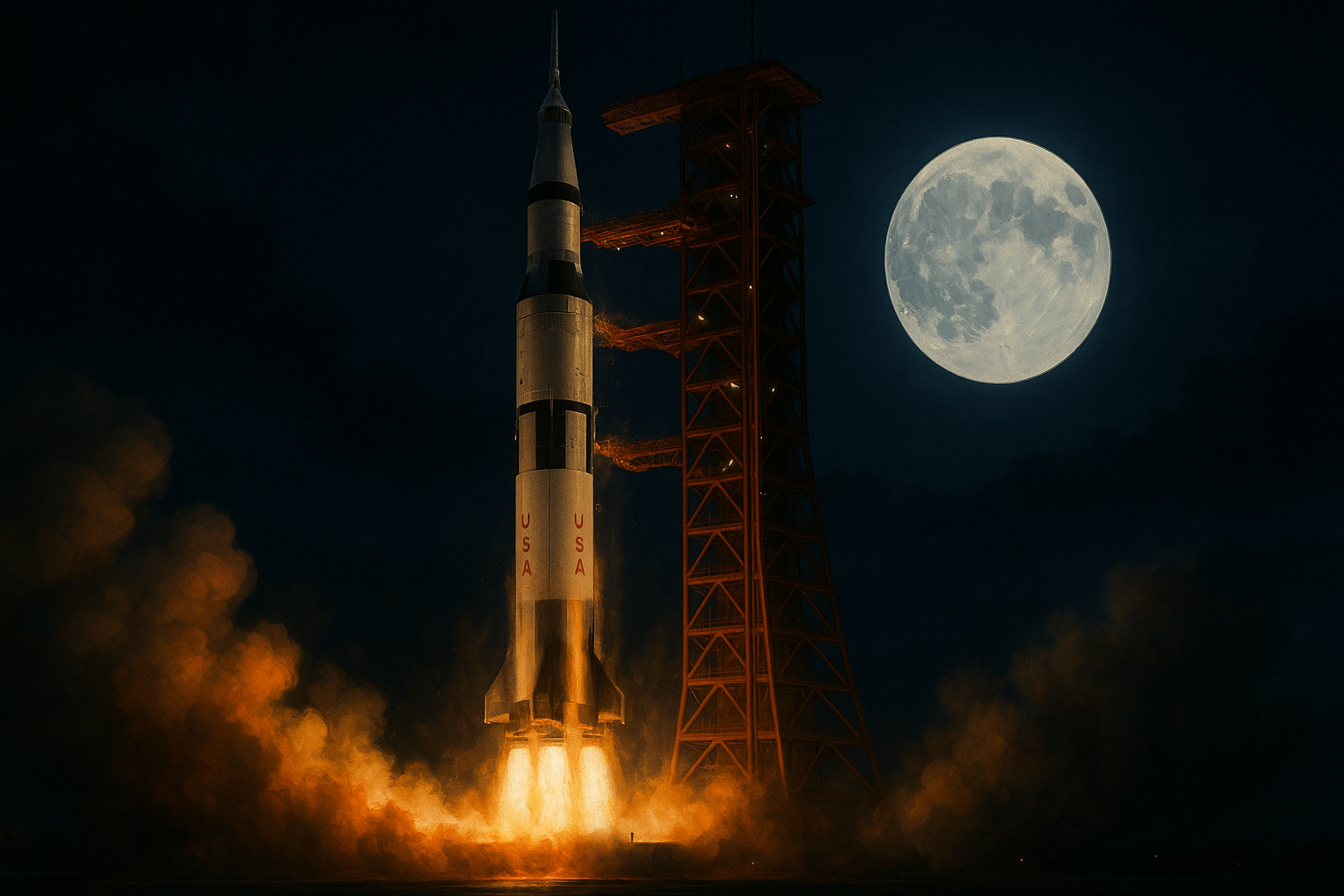Moonshots
Sometimes, it doesn't matter how difficult something is — you have to do it anyway.

I met my wife while playing World of Warcraft.
I knew almost right away it was a moonshot.
I knew it would be hard. We lived a thousand miles and half a country apart. We both had children in school. We were both exiting marriages that were no longer working.
I knew the odds, I knew I could fail. Statistically, that was probably the most likely outcome. A reasonable person would urge caution, or patience, to "be realistic" and play it safe.
I knew I was reaching, aiming for something beyond my probable orbit.
I knew all that, and yet I couldn't help myself.
I had to try anyway.
Why Choose This As Our Goal?
The word moonshot gets thrown around a lot these days.
Tech companies use it to describe ambitious R&D projects. Startups invoke it to pitch ideas that sound impossible. Politicians co-opt it to promise us a better future.
It's become a buzzword, sure, but that doesn't mean it lacks meaning. A moonshot is:
- A bold, ambitious, unlikely endeavor
- With a high chance of failure
- That, if successful, transforms what we believe is possible.
They are not just difficult, they're unknowably hard.
You won't know how to get there.
You don't know how to solve the problems that need solving
You can't even see all the problems you'll need to solve when you begin.
There is no map, no path, and no guarantee. There is only a goal – a destination, a place, a thing – that informs our initial direction.
And the question: What if we tried anyway?
There's something mythic in them that echoes the archetypical hero's journey — the call to adventure that pulls someone away from safety, into risk, fear, transformation.
You don’t take on a moonshot because it’s smart.
You take it on because not trying would feel like betrayal.
We Choose To Go To The Moon
The word moonshot is literal.
In 1961, the United States was losing the space race. Everywhere you looked, the Soviet Union had gotten there first.
First artificial satellite? Sputnik.
First animal in orbit? Laika.
First human in orbit? Yuri Gagarin.
We weren't just behind, and we weren't just fumbling rockets. We were losing the narrative. A nation that prides itself on leadership, coming in second place.
On September 12, 1962, President Kennedy came to Houston. On the field of the football stadium at Rice University, he delivered a masterwork of oratory before a crowd of 40,000 people. In it, he told us some hard truths that we desperately needed to hear. And then he gave us a vision of the future.
We choose to go to the moon. We choose to go to the moon in this decade and do the other things, not because they are easy, but because they are hard, because that goal will serve to organize and measure the best of our energies and skills, because that challenge is one that we are willing to accept, one we are unwilling to postpone, and one which we intend to win, and the others, too.
He didn't just declare a goal, he issued a challenge to the American imagination: Land a person on the moon, then return them safely to earth, before the end of the decade.
At the time, we didn't know how to manage an orbital rendezvous.
We didn't have the technology, the rockets or the computers.
We didn't even have the science to create them.
We were trying to build a future that we could dream of but not yet design.
The success of the Apollo program was not inevitable. Frankly, it was impossible — until thousands of engineers, scientists, and dreamers decided otherwise. Over the course of seven years of incremental success, layered breakthroughs and lateral problem solving, and hard work and relentless effort, we got there.
In July 1969, half a billion people tuned in to watch Neil Armstrong descend that ladder onto the lunar surface, heard him utter the legendary line, "that's one small step for a man, one giant leap for mankind."
The Eagle had landed.
Not Because They Are Easy, But Because They Are Hard
The original moonshot was every bit as difficult as you think.
The Saturn V rocket — the machine that launched the astronauts — was the tallest and most powerful vehicle ever built. Its main engines are still the most powerful engines ever made.
At over 5.6 million individual parts, it's also the most complex vehicle ever assembled. Even a 0.01% failure rate would mean hundreds of failures, any of which could have been fatal. And the system had to work perfectly, in three stages, across vacuum, orbit, lunar gravity, and atmospheric reentry.
Designing and building it was an important step, but it was also just the first of many. The success of the Apollo program required stacked breakthroughs:
- Launch Vehicle – building a rocket powerful enough to launch enough mass and with enough velocity to escape Earth's gravity and reach the Moon.
- Orbital Mechanics – figuring out how to navigate from Earth to the moon and back without GPS or modern computers.
- Human Life Support – keeping three men, across two spacecraft, alive for over a week's duration.
- Throttleable Descent and Ascent – designing a system that could land on the moon gently enough for squishy humans. Then, later, take off again and escape the Moon's gravity.
- Lunar Orbit Rendezvous – reconnecting and docking two independent spacecraft in lunar orbit.
For me, the most quietly awe-inspiring part of all of this wasn't the rocket at all. It was the Apollo Guidance Computer, the brains of the operation. It had to handle real-time telemetry, autonomously navigate through space, and run continuously without crashing.
And it did. It was amazing.
Yet in terms of processing power, it probably compares with a toaster (and not a particularly intelligent one either). An average modern smartphone has three thousand times the processing speed and six million times the memory and data storage.
It used something called core rope memory, which was a literal physical wire woven through and around tiny magnetic cores. The weave of the rope, skipping or passing through this core, represented the binary 0 and 1. The data was physically hard wired into memory by hand, weaving the code like textiles. It was extremely reliable, non-volatile, and compact, but it was permanent. Once woven, it couldn't be changed.
Need to update your software?
You can't. Go weave a new rope.
In a digital world, it's the most beautifully analog thing I can imagine.
Do All This, and Do It Right
Let's be real here — moonshots are uncommon for a reason.
They’re risky. They’re expensive. They fail more often than they succeed. And yet we keep doing them. I think this is because moonshots change us, whether they are successful or not.
- They inspire us. They make us ask bigger questions. They reset our sense of possibility.
- They test us. They force us to grow. They surface our limits, and make us work through or around them.
- They leave legacies. Even failed moonshots produce breakthroughs, new disciplines, or have us build new infrastructure.
- They pull the future forward. They collapse the distance between fantasy and reality.
And in a world that is often consumed by the incremental and the safe, avoiding risk, and afraid of failure, moonshots are a chance to re-examine who we could be.
What can we accomplish, if we stop asking, "what's realistic?"
And instead, we ask, "what is worth doing?"
We Must Be Bold
Moonshots rarely start off as popular.
They often require great sacrifice and tremendous effort. They take time, and that means sustained belief. They usually come with risks, striking out into the unknown. And quite often? They fail. That's scary.
Someone has to go first. It takes a special kind of leader to get a moonshot off the ground. They aren't always the person in charge, and they aren't always liked. But without them, nothing moves.
They need vision — to see what others can’t, or won’t.
They need courage — to risk credibility, comfort, even livelihood.
They need communication — to rally people to the cause.
They need perseverance — to survive setbacks and push through inertia.
And they need conviction — a moral clarity that says, this is the way forward.
Crucially, they see a vision of the future — not just what is, but what could be. And they can’t look away. They don’t lead because they want to.
They lead because they must.
They face resistance at first, but they do attract others to the cause. Their strength of belief gives others permission to dream with them. These people are dreamers, but they make that dream reality. And it doesn't matter what obstacles you stick in their way — bureaucracy, budgets, or just lagging belief systems — they'll find a way through.
And in so doing, they normalize having conversations about the impossible things, to the point that we accept that they aren't impossible at all.
They reframe the fear, and the risk.
The question isn't, "What happens when we fail?"
The true risk is, "What happens if we don't try?"
A Personal Moonshot
My moonshot was a success.
I met my wife in Azeroth, but that was only the beginning. She moved here, we bought a house, we've built a life together. We've endured many challenges together, and I'll admit it hasn't always been easy. And yet, these last four and a half years have been the happiest of my life, and she gives me more joy than I ever thought possible.
Early in our marriage, she gifted me my dream watch, an Omega Speedmaster Professional. It's a modern version, but it can trace its lineage to the original Speedmasters — the Moonwatch — worn by the Apollo astronauts. I keep mine on a custom nylon strap, with an emblem of the moon etched on the clasp.
When I first got into watches, I wanted a Speedmaster because I thought they were cool, that it would be awesome to wear the same watch worn on the moon. But this one, I wear as a reminder.
As a reminder of the wonderful woman who is the love of my life.
And as a reminder of the courage it takes to pursue what truly matters.
